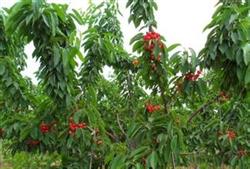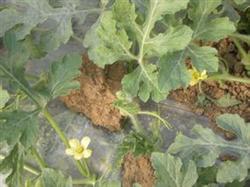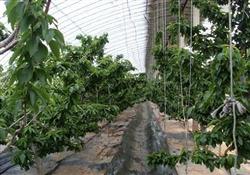Cherry cultivation

1. Variety selection, garden establishment and planting Chinese cherry has weak cold resistance and likes warm and moist climate, so it is suitable to be cultivated in places with an annual average temperature of 15-16 ℃. Sweet cherries like cold and dry. The natural dormancy period of cherry is about 80,100 days. The chilling requirement for sweet cherry to complete dormancy is 1 100 to 1 300 hours below 7.2℃. Sour cherries take 1200 to 2500 hours. The dormancy period of Chinese cherry is short, and it is easy to germinate when the temperature warms up in late winter and early spring. if it is cold in late spring (frost or snow), the flower organs will be frozen, which will seriously affect the yield and even no harvest. Therefore, in the course of development, we must pay attention to whether the attack time of the low temperature and cold wave in the local spring coincides with the flowering period, and cannot be planted in places where adverse weather (frost, snow, strong wind) occurs during the flowering period of cherries. Even if there are few places with disastrous weather, it is necessary to choose suitable small terrain for planting when building the garden. The annual rainfall suitable for cherry growth is generally 700mm to 1000mm. Some areas in the south should fully consider how to solve the problem of "early spring" when building a garden. Because drought in the early stage of fruit growth will cause serious fruit drop and affect fruit growth and development. Cherry is a light-loving tree species, Chinese cherry is more shade-tolerant, but the light is good, the fruit ripens early and the color is good. Cherry is suitable for cultivation in sandy soil with rich and loose soil and deep soil layer. Soil acidity and alkalinity, usually PH6.0~7.5. The vertical distribution of Chinese cherry roots is generally concentrated in the soil layer about 20 cm deep, which requires loose soil and good drainage and irrigation conditions. Heavy clay is not suitable for growing cherries. As cherries are not resistant to transportation, a garden should be built in a location with convenient transportation. Planting density should vary according to varieties, rootstocks and soil conditions. On fertile flat land, Chinese cherries are densely planted with Y-shaped shaping, which can be planted at a rate of 1 × 3 meters, 220 plants per mu, and 2 × 3 meters × 3 meters per mu if natural cluster shape or natural happy shaping is adopted. The density can be increased properly in infancy, and thinning measures can be taken after the orchard is formed. Planting time is generally divided into two periods: autumn and spring. It should be planted in spring in cold, dry and windy areas in winter, and spring planting should be before seedlings germinate. Autumn can be planted in warm places in winter. Deep soil ripening should be carried out before planting, and large planting holes should be dug. 25-50 kg of organic fertilizer was applied to each hole. After mixing the fertilizer with the soil, plant the seedlings and immediately pour the root water. 2. Soil, fertilizer and water management of cherry soil management, according to our experimental observation: spring irrigation plus mulching, other seasons for ploughing and weeding management method is better. Because mulching alleviates the effect of spring drought on plants, it has a good effect on fruit growth. Remove or bury the mulch after cherry harvest. According to the calculation, the general adult garden should cover 2000,2500 kilograms of wheat stalk per mu. Cherry trees should be fertilized 3 or 4 times a year. That is: 1. Fertilization after fruit harvest is mainly to restore tree potential, promote flower bud differentiation and increase next year's yield. Immediately after fruit picking, stable manure, livestock manure and urine were applied, and appropriate amount of chemical fertilizer was added. Each plant applies 30kg of livestock manure depending on the result. 2. Fertilizing before sprouting and flowering, fertilizing and topdressing with available nitrogen fertilizer as the main fertilizer. Each plant was treated with 1520 kg of livestock manure or 0.5 kg of urea. 3. Fruit rapid long-term fertilization enters fruit development after flowering. Quick-acting chemical fertilizer should be applied to fruiting trees once, and an appropriate amount of phosphorus and potassium fertilizer should be applied. 4. Apply basic fertilizer before defoliation in autumn from September to October (from October to November in southern warm areas) to rejuvenate the tree and increase the content of stored nutrients in the plant. As the cherry takes only more than 40 days from flowering to fruit ripening, the amount of stored nutrients affects the size and quality of the fruit to a great extent. Therefore, the application of base fertilizer is very important, accounting for 50% to 70% of the annual fertilizer application. It should be mainly organic fertilizer, such as compost, ring manure, chicken manure, rotten bean cake, etc., and an appropriate amount of superphosphate or calcium methophosphate fertilizer should be added. In addition to the above-mentioned soil fertilization, 0.5% urea, or 600 times potassium dihydrogen phosphate, or 0.3% borax solution was sprayed twice at intervals of 10 days from the early flowering stage to the full flowering stage, which was helpful to improve the fruit setting rate. Third, plastic pruning 1, plastic surgery a. The natural cluster shape is a common tree shape of Chinese cherries. Generally, there are 5-6 main branches, which open and grow in all directions, and there are 3-4 lateral branches on each main branch. As a result, the branches were planted on the main and lateral branches. After senescence, the main branches were regenerated by sprouting. The angle of this tree is faster than that of opening, the shape is faster, and the result is earlier. But the inside of the crown is easy to close. b. Natural happy shape is mostly used for sweet cherries. The dry height is 30cm to 40cm, and the whole tree has three main branches with a branch angle of 30 degrees. At first, the central stem was preserved, and after 5 years of planting, the central stem was happy after it was removed. This kind of tree has the advantages of easy shaping, small pruning, open crown, good ventilation and light transmission, early fruit, high yield and good fruit quality. c. The trunk is sparsely stratified and 40-60 cm high, with a central trunk. The number of main branches is 6-7, which is divided into 3-4 layers and is scattered on the central trunk. There are 3 main branches in the first layer with an opening angle of 50-60 degrees, 2 main branches in the second layer with an opening angle of about 45 degrees, and one main branch in the third and fourth layers. The distance between the first and second layers is 60-80cm, the distance between the second and third layers is 40cm-50cm, and the distance between the upper layers can be smaller. Each main branch is equipped with 2-4 lateral branches. At the same time, the fruiting branches were cultured on all levels of backbone branches. D. The "Y" tree is oriented north and south, with two main branches symmetrically on both sides of each tree. A support frame needs to be set up during plastic surgery. The tree has the advantages of good ventilation and light transmission, easy flowering and fruiting, suitable for close planting, convenient management and good fruit quality. 2. Prune a. Pruning should pay attention to the fact that the branches of cherries can be divided into two types: developmental branches and fruiting branches. there are more developing branches on young trees, the front leaf buds extend and expand the crown, and the lower axillary buds produce fruiting branches. After entering the fruiting stage, the terminal buds of most annual branches are outside the leaf buds, and most of the axillary buds are flower buds, which are called fruiting branches. The fruiting branch can be divided into long fruit branch (15 cm), middle fruit branch (5 cm), short fruit branch (5 cm) and flower cluster fruit branch (1 cm) according to their length. In terms of fruiting ability, the fruiting ability of long fruit branches is poor, generally about 40%; the fruiting ability of middle fruit branches varies from variety to variety; the fruit setting rate of short fruit branches is high, and the fruit quality is also good; flower clusters of fruit branches are the main fruit branches in prosperous trees, and the fruit setting rate can reach about 80%. The fruit has the best quality and long life, and can bear fruit continuously for 10 to 20 years. Fruiting branches and flower-shaped fruit branches are the basis of yield formation. Chinese cherry and sour cherry have a large proportion of long and medium fruit branches in the early fruit stage, while they are mainly short fruit branches and flower-shaped fruit branches in the full fruit stage. b. Pruning of young trees in order to promote early fruit of young trees, on the basis of shaping, the degree of pruning of all kinds of branches should be light, mainly in the growing period. In order to control the growth of branches, increase branches, add speed to expand the crown. The time of pruning in winter should be postponed to before budding to avoid dehydration and dryness of the cut. Except for short cutting of main branches and extended branches and appropriate thinning of some overdense and crossed branches, the rest of the middle and branchlets should be retained as far as possible. c. The pruning of fruit trees is often pruned in summer after fruit harvest. Thinning was used to remove the perennial branches which were too dense and disturbed the crown to adjust the crown structure and promote the formation of flower buds. When removing the big branches, pay attention to the wound to be small and flat, so as to heal as soon as possible. When thinning one-year-old branches, you can first cut above the axillary flower buds at the base, and then remove them after the results are bald. When pruning in winter, attention should be paid to the proper retraction of the tip of the backbone branch and the 2-3-year-old branch segment of the short fruit branch, so as to stimulate the vegetative growth and the continuous formation of new fruit branches, and prevent the outward movement of the fruit part and the internal baldness of the crown. d. The main task of pruning aging trees is to renew and rejuvenate in time and make use of strong growing branches to form new crowns. If the backbone branches are weak at first and do not have the ability to bear fruit, they should withdraw in time. When using hidden buds to retract and renew, the life span of hidden buds of Chinese cherry is about 5-10 years. In order to retract and have branches to renew, it is better to have small branches with more normal growth at the retracted place, which does less damage to the tree. After retraction and pruning, select the direction, position, proper growth and outward development of the branches to cultivate new main branches and lateral branches. Too much should be removed, and the rest should be cut short to promote branching, and then released slowly to form a fruiting branch group. When the twig is renewed, it should also be carried out after fruit picking, so as not to cause glue flow from the wound. Fourth, flower protection, fruit protection and flower protection should mainly pay attention to the management of fertilizer and water in spring, so as to promote the construction of flower organs and normal flowering. The purpose of fruit preservation is to improve the fruit setting rate of healthy fruit. Measures include: artificial pollination; pollination by visiting flowers by insects; spraying plant hormones, such as gibberellin (GA3), PP333, chlorfenac foliar fertilizer, etc.; in order to promote strong fruit, it is necessary to thinning flowers and fruits and prevent and reduce fruit cracking.
- Prev

"five looks" to distinguish whether watermelons are sitting or not
The ovary of precocious watermelon is generally round (a few are oblong), and the female flowers with few hairs, thick and long fruit stalk and large petals are easy to sit on watermelon. Fruit-shaped oval melons (mostly mid-late ripening varieties), ovaries are oblong, hairy, fruit stalks thick and long, petals large female flowers easy to sit melon; the reverse is not easy.
- Next

Key techniques of Cherry cultivation
(1) soil management soil management should first lay a good foundation before planting and continue to improve the soil after planting. 1. Enlarge the acupoint and turn deeply. The method is to start from the edge of the planting hole and expand outward every year or every other year, digging a circular groove of about 50cm wide and deep 60cm until the two trees meet each other. Turn it deep.
Related
- Moge, come on! The staff of the peasant association in the producing area of cantaloupe were frightened when the crowd gathered.
- Causes and Solutions of low Fruit setting rate of Apple
- Symptoms and control measures of passion fruit virus disease
- Fruit growing lesson: how do apple orchards keep high yields?
- Can you build orchards in the mountains? What are the pros and cons?
- How to manage the coloring period of Crisson grape?
- This paper introduces the processing technology of two kinds of fig products.
- How much is a month for retired teachers in rural areas by 2020?
- How can strawberry planting increase sugar content? We should pay attention to management in many aspects.
- What are the cultivation techniques on how to improve the yield of golden fruit?

